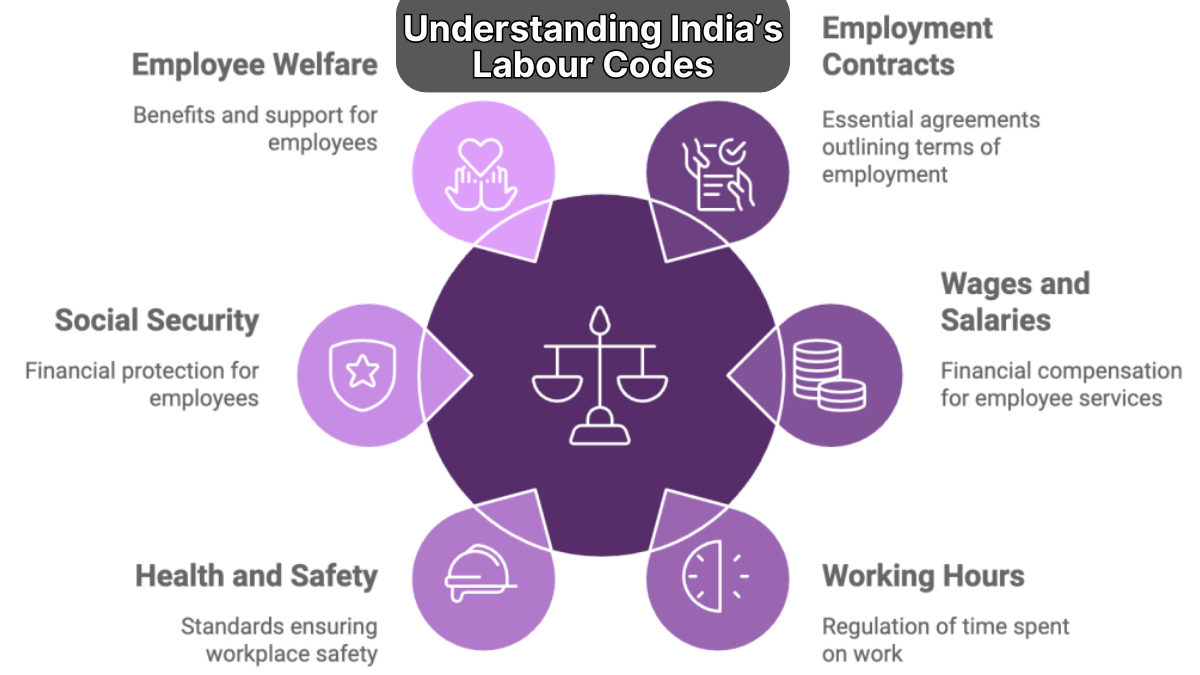India stands on the brink of its most significant employment transformation in decades. The new labor codes set to launch in August 2025 will fundamentally reshape how millions of workers and thousands of companies operate across the country.
These comprehensive reforms consolidate 29 existing labor laws into four streamlined codes, promising greater clarity, enhanced worker protection, and improved business efficiency. For employees, this means changes to salary structures, working hours, and benefits. For employers, it signals a shift toward simplified compliance and modernized workplace standards.

Understanding these changes now is crucial for both workers and businesses to prepare for the transition ahead. The reforms will affect everything from your monthly paycheck to your retirement savings, making it essential to grasp what’s coming and how it will impact you.
Understanding the Four New Labor Codes
The 2025 labor reforms replace India’s complex web of employment laws with four consolidated codes. Each code addresses specific aspects of the modern workplace:
Code on Wages
This code governs minimum wage standards, payment timelines, and equal compensation policies. It ensures workers receive fair pay while establishing clear guidelines for employers on wage calculations and disbursement schedules.
Industrial Relations Code
Covering trade union operations, strike procedures, and employment terms, this code balances worker rights with business needs. It introduces standardized processes for resolving workplace disputes and managing labor relations.
Code on Social Security
This comprehensive framework extends benefits like Provident Fund (PF), Employee State Insurance (ESI), and gratuity to a broader workforce, including gig workers and contract employees previously excluded from such protections.
Occupational Safety, Health, and Working Conditions Code
The OSH Code prioritizes workplace safety through mandatory health audits, updated safety protocols, and enhanced welfare measures. It reflects modern understanding of workplace hazards and employee well-being.
Major Changes to Working Hours and Schedules
The new codes introduce flexible working arrangements that could revolutionize India’s traditional work culture. Daily working hours may extend to 12 hours, but the weekly limit remains capped at 48 hours.
This change opens the door for four-day work weeks, allowing employees to work longer days in exchange for an additional day off. Companies adopting this model must ensure proper overtime compensation for hours exceeding the standard eight-hour workday.
The flexibility benefits both parties: employees gain better work-life balance opportunities, while employers can optimize operations based on business demands. However, strict overtime regulations ensure workers receive fair compensation for extended hours.
Wage Structure Revolution: The 50% Basic Pay Rule
Perhaps the most impactful change involves wage structure redefinition. Under the new codes, basic salary must constitute at least 50% of total compensation, a significant increase from the current 25-40% range many companies follow.

This shift affects multiple financial aspects:
Provident Fund contributions will increase since PF calculations are based on basic salary. Higher basic pay means larger PF deductions from both employee and employer sides.
Gratuity calculations will improve for workers, as gratuity is computed using basic salary figures. This change particularly benefits long-term employees approaching retirement.
Take-home pay may decrease slightly due to higher PF contributions, but employees gain substantially more in retirement savings and long-term financial security.
Tax implications vary depending on individual circumstances. While higher PF contributions reduce taxable income, the overall impact depends on salary levels and tax brackets.
Enhanced Leave Policies and Benefits
The new labor codes bring welcome changes to leave management. Unused annual leave can now be carried forward to subsequent years or encashed according to company policies and statutory guidelines.
This flexibility addresses a common workplace frustration where employees lost accumulated leave due to rigid use-it-or-lose-it policies. The new system encourages better work-life balance while ensuring employees receive compensation for unused entitlements.
Companies must develop clear policies on leave encashment rates and carry-forward limits, providing transparency that benefits both parties in employment relationships.
Expanded Social Security Coverage
One of the most progressive aspects of the new codes is extended social security coverage. Gig workers, platform employees, and contract staff will now access benefits previously reserved for permanent employees.
This expansion reflects India’s evolving employment landscape, where traditional full-time positions increasingly give way to flexible work arrangements. Food delivery drivers, ride-share operators, freelancers, and temporary workers can now participate in formal social security systems.
The change addresses a critical gap in worker protection while acknowledging the legitimacy and importance of non-traditional employment relationships in the modern economy.
Workplace Safety and Women’s Rights
The OSH Code introduces enhanced safety measures across industries. Mandatory health and safety audits will become standard for specific sectors, ensuring consistent application of safety protocols.
Women workers receive particular attention in the new framework. The codes allow women to work night shifts with appropriate safety measures in place, expanding employment opportunities while maintaining security standards.
These provisions reflect contemporary workplace realities and gender equality principles, moving beyond outdated restrictions that limited women’s career advancement opportunities.
Implementation Timeline and State Adoption
The central government aims to implement these codes from August 2025, but actual rollout depends on individual state adoption. Since labor is a concurrent subject under India’s constitution, both central and state governments must coordinate for effective implementation.
States may adapt certain provisions to local conditions while maintaining the core framework’s integrity. This flexibility allows regional customization while ensuring national consistency in fundamental worker rights and protections.
Businesses operating across multiple states should prepare for potential variations in implementation timelines and specific requirements, making comprehensive compliance planning essential.
Preparing for the Transition
Both employers and employees need strategic preparation for these sweeping changes. Companies should review current compensation structures, update HR policies, and train management teams on new compliance requirements.
Employees should understand how wage restructuring affects their financial planning, particularly regarding take-home pay and retirement savings. Those in non-traditional employment arrangements should explore newly available social security benefits.
Professional consultation may prove valuable for complex situations, especially for businesses with diverse workforce structures or employees with significant financial planning concerns.

FAQs on India’s New Labor Codes 2025
1. What are India’s new labor codes?
India’s new labor codes are a set of four consolidated laws aimed at simplifying and modernizing the country’s labor regulations. They cover Wages, Industrial Relations, Social Security, and Occupational Safety, Health, and Working Conditions, replacing 29 existing labor laws.
2. When will the new labor codes come into effect?
The new labor codes are set to be implemented starting August 2025.
3. How will the new wage structure impact employees?
The new wage structure ensures a standardized definition of wages, which may lead to changes in basic pay and benefits like provident fund contributions. Employees may see adjustments in take-home pay and long-term savings.
4. What changes can employers expect in compliance requirements?
Employers will benefit from simplified compliance procedures due to the consolidation of laws. Digital record-keeping and streamlined reporting requirements will reduce administrative burdens.
5. Will the labor codes enhance social security for workers?
Yes, the new labor codes aim to expand social security benefits to a larger section of the workforce, including gig and platform workers, ensuring better financial security and healthcare access.
6. Are there any changes to working hours?
The new labor codes provide flexibility in working hours, allowing for a four-day workweek while maintaining a 48-hour work requirement. Overtime provisions have also been revisited.
7. How can organizations prepare for these changes?
Organizations should review current employment policies, update wage and compliance systems, and train HR teams to align with the new regulations. Proactive steps will ensure a seamless transition when the codes come into effect.
What These Reforms Mean for India’s Future
The new labor codes represent more than policy updates—they signal India’s commitment to creating a modern, inclusive, and competitive employment environment. By balancing worker protection with business flexibility, these reforms position India for sustainable economic growth.
The emphasis on social security expansion acknowledges changing work patterns while ensuring basic protections for all workers. Enhanced workplace safety standards demonstrate commitment to employee welfare, while flexible working arrangements support productivity and work-life balance.
Success depends on effective implementation, proper awareness among stakeholders, and continuous adaptation based on real-world experience. These reforms lay the groundwork for India’s next phase of economic development, prioritizing both worker welfare and business growth.
As August 2025 approaches, staying informed about these changes and preparing accordingly will determine how smoothly individuals and organizations navigate this historic transition in India’s employment landscape.
Click HERE For More.
